
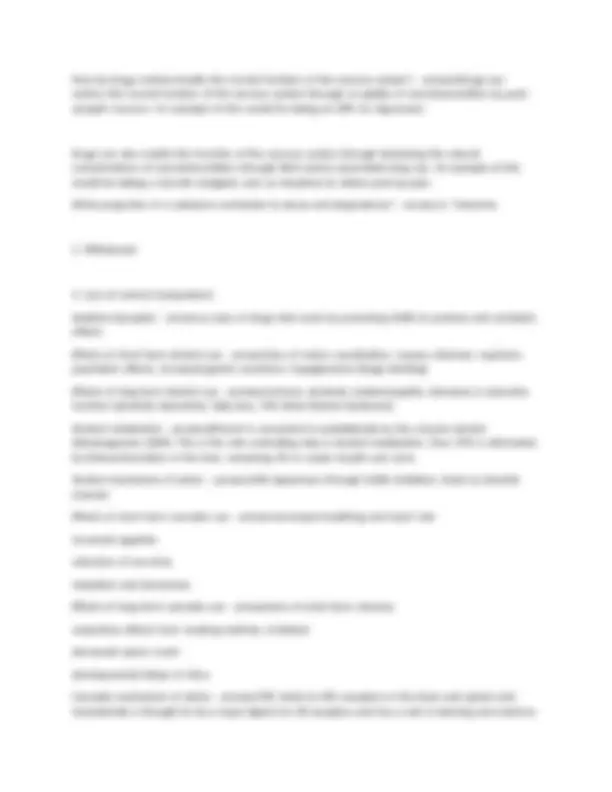
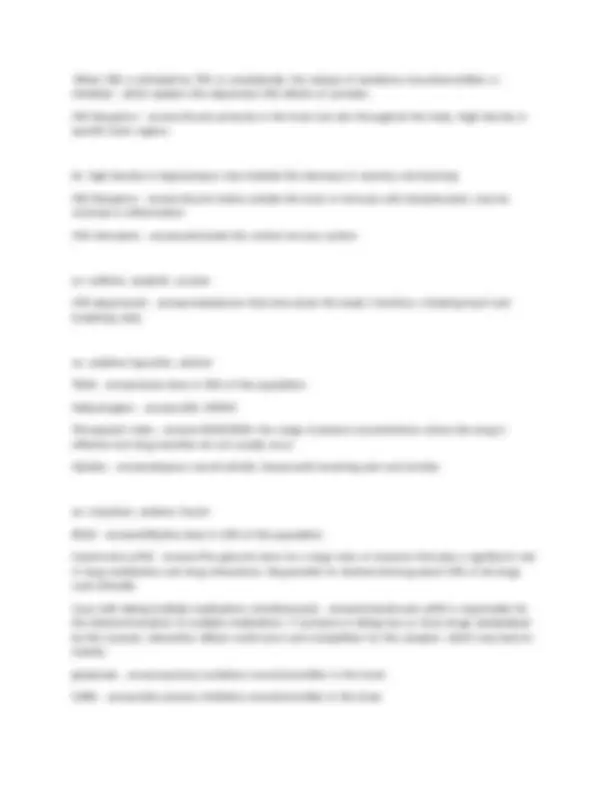
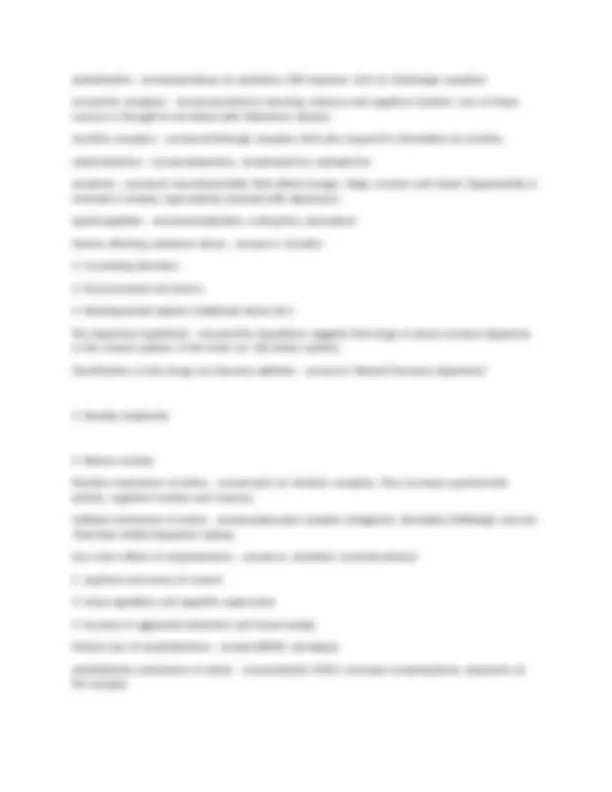
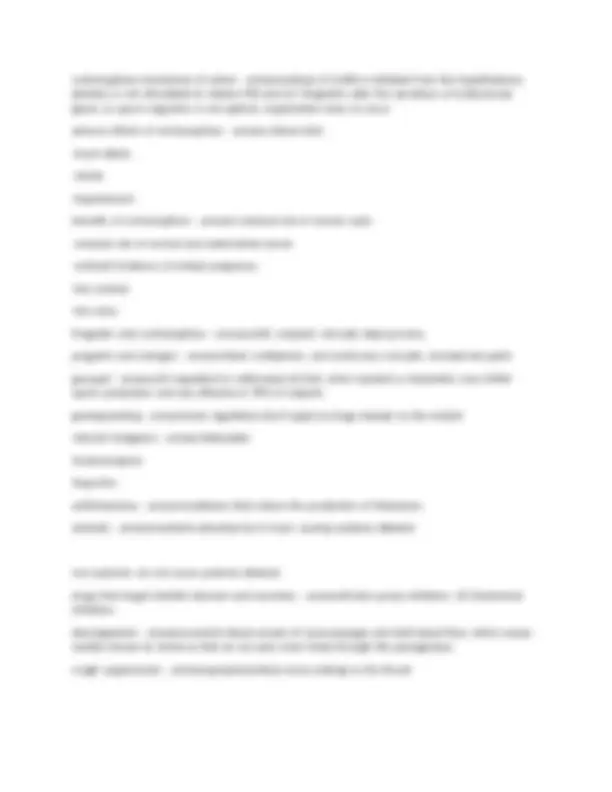
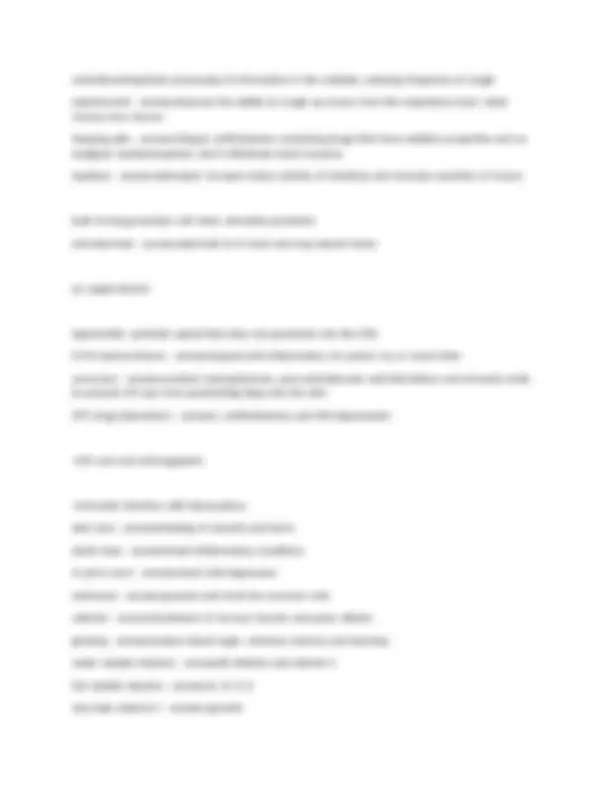
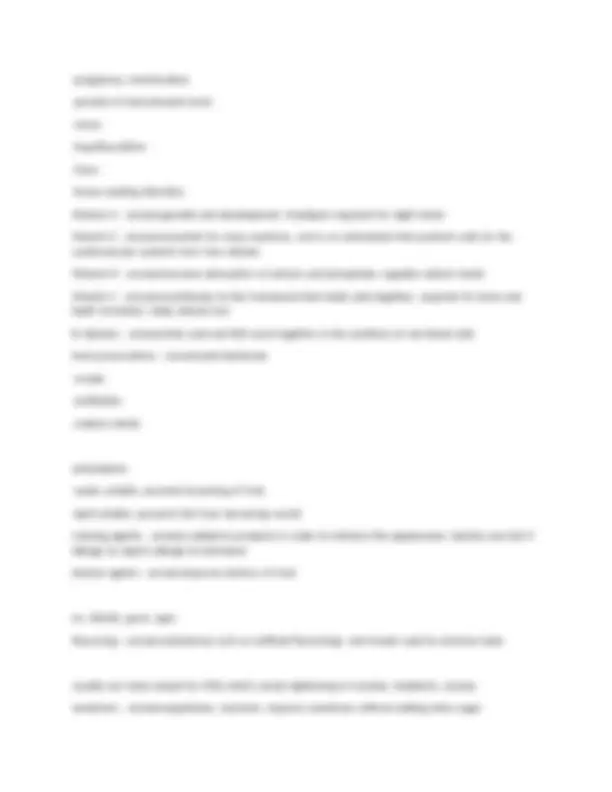


Study with the several resources on Docsity

Earn points by helping other students or get them with a premium plan


Prepare for your exams
Study with the several resources on Docsity

Earn points to download
Earn points by helping other students or get them with a premium plan
Community
Ask the community for help and clear up your study doubts
Discover the best universities in your country according to Docsity users
Free resources
Download our free guides on studying techniques, anxiety management strategies, and thesis advice from Docsity tutors
PHAR 100 – Introduction to Pharmacology Final Exam
Typology: Exams
1 / 12

This page cannot be seen from the preview
Don't miss anything!







Path |of |drug |from |when |it |enters |to |exits |the |body |- |answers1. |Absorption
body. |The |subsequent |activation |of |this |receptor |in |other |areas |of |the |body |is |an |example |of |an | adverse |effect. Adverse |effects |- |answers1. |Extension |of |therapeutic |effect
|When |CB1 |is |activated |by |THC |or |anandamide, |the |release |of |excitatory |neurotransmitters |is | inhibited |, |which |explains |the |depressive |CNS |effects |of |cannabis. CB1 |Receptors |- |answersFound |primarily |in |the |brain |but |also |throughout |the |body. |High |density |in | specific |brain |regions. Ex; |high |density |in |hippocampus |may |mediate |the |decrease |in |memory |and |learning CB2 |Receptors |- |answersfound |mainly |outside |the |brain |in |immune |cells |(lymphocytes), |may |be | involved |in |inflammation CNS |stimulants |- |answersstimulate |the |central |nervous |system ex: |caffeine, |amphets, |cocaine CNS |depressants |- |answersSubstances |that |slow |down |the |body's |functions, |including |heart |and | breathing |rates. ex: |sedative |hypnotics, |alcohol TD50 |- |answerstoxic |dose |in |50% |of |the |population Hallucinogens |- |answersLSD, |MDMA Therapeutic |Index |- |answersTD50/ED50- |the |range |of |plasma |concentrations |where |the |drug |is | effective |but |drug |toxicities |do |not |usually |occur. Opiates |- |answersdepress |neural |activity, |temporarily |lessening |pain |and |anxiety ex: |morphine, |codeine, |heroin ED50 |- |answersEffective |dose |in |50% |of |the |population Cytochrome |p450 |- |answersThe |general |name |for |a |large |class |of |enzymes |that |play |a |significant |role | in |drug |metabolism |and |drug |interactions. |Responsible |for |biotransforming |about |50% |of |all |drugs | used |clinically. Issue |with |taking |multiple |medications |simultaneously |- |answersCytochrome |p450 |is |responsible |for | the |biotransformation |of |multiple |medications. |If |someone |is |taking |two |or |more |drugs |metabolized | by |this |enzyme, |interaction |effects |could |occur |and |competition |for |the |receptor, |which |may |lead |to | toxicity. glutamate |- |answersprimary |excitatory |neurotransmitter |in |the |brain GABA |- |answersthe |primary |inhibitory |neurotransmitter |in |the |brain
acetylcholine |- |answersproduces |an |excitatory |CNS |response. |Acts |on |cholinergic |receptors muscarinic |receptors |- |answersinvolved |in |learning, |memory |and |cognitive |function. |Loss |of |these | neurons |is |thought |to |be |linked |with |Alzheimers |disease. nicotinic |receptors |- |answerscholinergic |receptors |that |also |respond |to |stimulation |by |nicotine catecholamines |- |answersdopamine, |norepinephrine, |epinephrine serotonin |- |answersA |neurotransmitter |that |affects |hunger, |sleep, |arousal, |and |mood. |Hyperactivity |is | involved |in |anxiety, |hypo-activity |involved |with |depression. opioid |peptides |- |answersenkephalins, |endorphins, |dynorphins Factors |affecting |substance |abuse |- |answers1. |Genetics
Gram-negative |bacteria |- |answersBacteria |that |have |complex |cell |walls |with |a |thin |peptidoglycan | layer, |and |an |outer |membrane. |Very |toxic |and |hard |to |treat. Broad |spectrum |antibiotics |- |answersaffect |a |broad |range |of |gram-positive |or |gram-negative |bacteria ex: |tetracyclines Narrow |spectrum |antibiotics |- |answersEffective |against |specific |bacteria ex: |penicillin |G Fluroquinolones |- |answersinhibit |bacterial |DNA |synthesis ex: |ciprofloxacin Penicillins |and |cephalosporins |- |answersinhibiting |transpeptidase, |causing |the |cell |wall |to |lyse |and | inhibiting |cell |wall |formation tetracyclines |- |answersinhibits |bacterial |protein |synthesis |by |binding |to |the |30S |ribosomal |subunit ex: |doxycycline macrolides |- |answersinhibit |protein |synthesis |by |binding |to |the |50S |ribosomal |subunit ex: |erythromycin, |azithromycin sulfonamides |- |answersblock |folate |metabolism |by |inhibiting |PABA |incorporation |into |dihydropteroic | acid trimethoprim |- |answersblock |folate |metabolism |by |inhibiting |dihydrofolic |acid |reductase How |does |antibiotic |resistance |occur? |- |answersEvolution: |Antibiotics |kill |the |bad |bacteria, |and |the | good |bacteria |that |protects |the |body |from |infection. |the |bacteria |become |drug |resistant, |and |can | take |over |and |give |the |resistance |to |other |bacterial |cells. | Also: |misuse |of |antibiotics |clinically |(over-prescription |or |misdiagnosis) |and |antibiotics |in |the | environment |(through |agriculture) which |penicillin |is |resistant |to |penicillinase? |- |answersMethicillin
contraceptives |mechanism |of |action |- |answersrelease |of |GnRH |is |inhibited |from |the |hypothalamus, | pituitary |is |not |stimulated |to |release |FSH |and |LH. |Progestins |alter |the |secretions |of |endocervical | gland, |so |sperm |migration |is |not |optimal, |implantation |does |no |occur. adverse |effects |of |contraceptives |- |answers-blood |clots -heart |attack -stroke -hypertension benefits |of |contraceptives |- |answers-reduced |risk |of |ovarian |cysts -reduced |risk |of |cervical |and |endometrial |cancer -reduced |incidence |of |ectopic |pregnancy -less |anemia -less |acne Progestin |only |contraceptives |- |answersIUD, |norplant, |mini-pill, |depo-provera progestin |and |estrogen |- |answersfixed, |multiphasic, |and |continuous |oral |pills, |transdermal |patch gossypol |- |answersAn |ingredient |in |cottonseed |oil |that, |when |injected |or |implanted, |may |inhibit | sperm |production |and |was |effective |in |99% |of |subjects grandparenting |- |answersnew |regulations |don't |apply |to |drugs |already |on |the |market Internal |Analgesics |- |answersSalicylates Acetaminophen Ibuprofen antihistamines |- |answersmedicines |that |reduce |the |production |of |histamines antacids |- |answerssystemic-absorbed |by |GI |tract, |causing |systemic |alkalosis non-systemic- |do |not |cause |systemic |alkalosis drugs |that |target |(inhibit) |stomach |acid |secretion |- |answersProton |pump |inhibitors, |H2 |(histamine) | inhibitors decongestants |- |answersconstrict |blood |vessels |of |nasal |passages |and |limit |blood |flow, |which |causes | swollen |tissues |to |shrink |so |that |air |can |pass |more |freely |through |the |passageways cough |suppressants |- |answersperipheral-block |nerve |endings |in |the |throat
-pregnancy, |menstruation -periods |of |hard |physical |work -stress -hypothyroidism -fever -tissue |wasting |disorders Vitamin |A |- |answersgrowth |and |development, |rhodopsin |required |for |night |vision Vitamin |E |- |answersessential |for |many |reactions, |and |is |an |antioxidant |that |protects |cells |(in |the | cardiovascular |system) |from |free |radicals Vitamin |D |- |answersincrease |absorption |of |calcium |and |phosphate, |regulate |calcium |levels Vitamin |C |- |answerscontributes |to |the |framework |that |holds |cells |together, |required |for |bone |and | teeth |formation, |helps |absorb |iron B |vitamins |- |answersfolic |acid |and |B12 |work |together |in |the |synthesis |of |red |blood |cells food |preservatives |- |answersanti-bacterials -smoke -antibiotics -sodium |nitrite antioxidants -water |soluble: |prevents |browning |of |fruit -lipid |soluble: |prevents |fats |from |becoming |rancid coloring |agents |- |answers-added |to |products |in |order |to |enhance |the |appearance, |toxicity |rare |but |if | allergic |to |aspirin |allergic |to |tartrazine texture |agents |- |answersimprove |texture |of |food ex: |silicate, |gums, |agar flavouring |- |answerssubstances |such |as |artificial |flavourings, |and |smoke |used |to |enhance |taste usually |non |toxic |except |for |MSG |which |causes |tightening |of |muscles, |headache, |nausea sweetners |- |answersaspartame, |saccharin, |improve |sweetness |without |adding |extra |sugar
environmental |toxicant |- |answerschemical |that |is |released |into |the |environment |and |can |produce | adverse |health |effects |on |living |organisms acute |toxicity |- |answersadverse |effects |that |occur |within |a |short |period |after |exposure |to |a |toxicant chronic |toxicity |- |answersadverse |effects |that |occur |some |time |after |exposure |to |a |toxicant |or |after | extended |exposure |to |the |toxicant common |environmental |toxicants |- |answers1. |Air |pollution